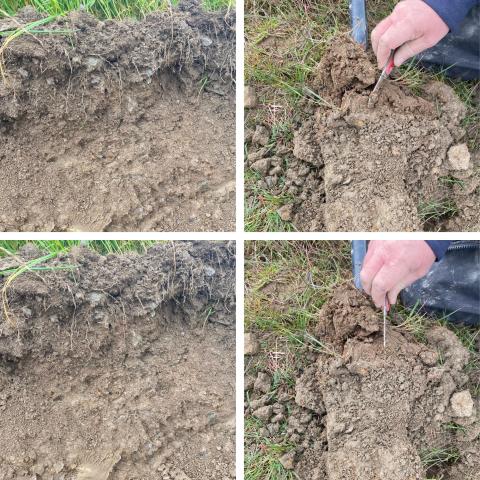Nant Y Fran Project Update July 2024
Following a whole farm soil assessment at Nant Y Fran with Chris Duller on 25 April 2024, three fields were identified for a detailed assessment and the key points are highlighted below.
Soils were visually assessed and scored according to the AHDB soil health scorecard and three core samples were taken from both 0-10 and 10-20 cm depth in each field to determine soil moisture and bulk density. Also, three water infiltration columns were installed to compare infiltration rates over 15 minutes in each field.
Cae Mawr
- Soil Health scorecard score = 2 – slight tight layer at 10-15cm depth – but no signs of major compaction damage
- The surface layers were clearly quite wet and the soil was easily deformed with 33% moisture noted in the top 0-10 cm
- Infiltration rates averaged 10.5mm
- There was no significant worm activity
Cae Dan Ty Bach
- Soil Health scorecard score = 1.75 – slight tight layer at 12-15cm (cultivation depth) with some evidence of old sward at that depth
- Good root growth – no worm activity
- Infiltration rates of 75mm
Cae Ty Gors
- Inspection pits were highly variable – with parts of the field showing clear compaction damage (probably from machinery damage)
- Soil Health scorecard score ranged from 1.5-4 – with the tightest soil layers being at around 10-15 cm
- Infiltration rates were also variable – 5-25mm – again there was little sign of worm activity
Soil remediation options following assessment include:
- The soil texture limits drainage in very wet periods so mechanical activity to open up pathways and increase infiltration should be beneficial.
- Surface aeration is likely to produce only short-term benefits (the silty soils tend to close up the aeration slots quite quickly) and most of the tight layering identified is below the operating depth of the slot aerators.
- The use of a grassland subsoiler is likely to be a more appropriate option for the soil type – although it has to be recognised that these machines will still only move water down through the profile at a slightly faster rate. It does not remove water from the soil profile – and if the water is backing up from an impermeable layer at depth, then improving drainage will be the only permanent solution (increasing density of field drains).
- The lack of earthworm activity is a concern - although the reasons for their absence are not clear – it may be associated with slurry management, particularly when soils are at a high soil moisture level.

